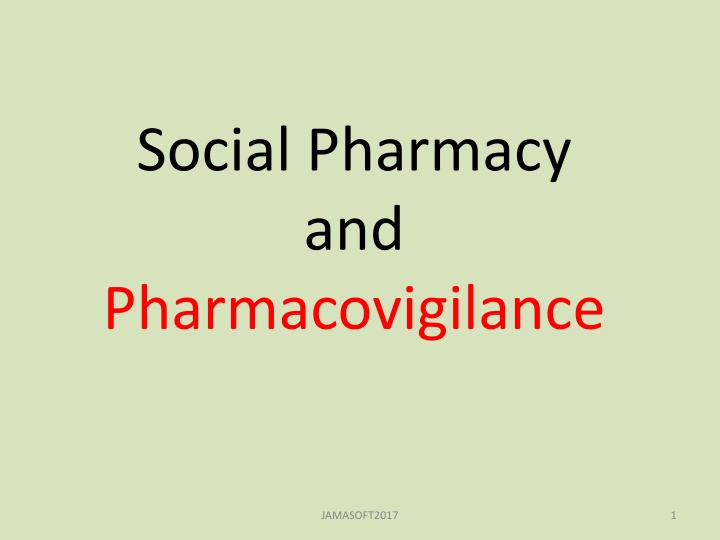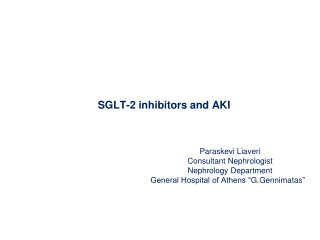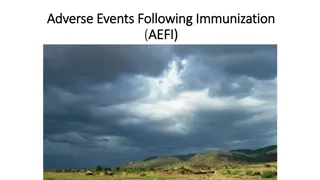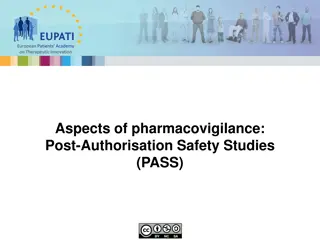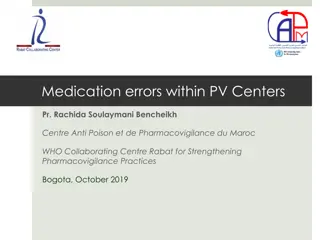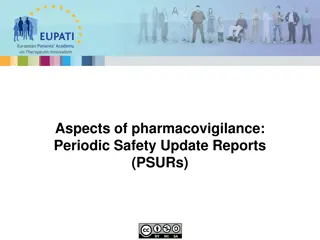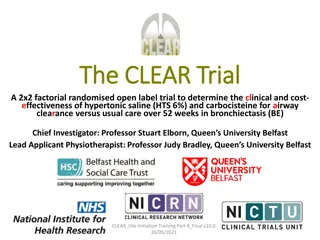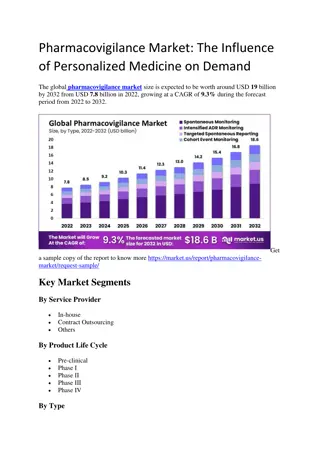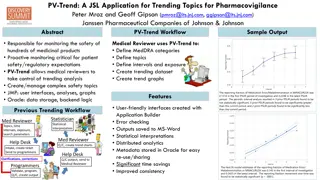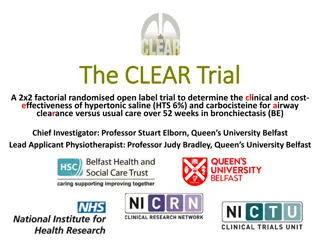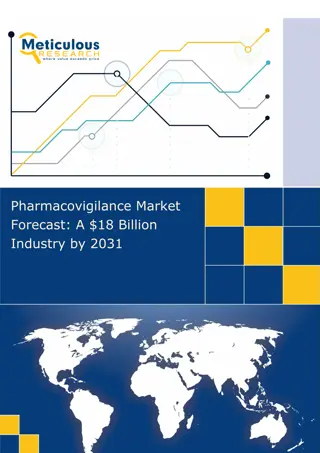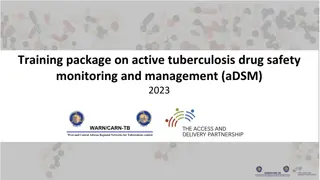Introduction to Pharmacovigilance
Pharmacovigilance is the science of monitoring and improving medicine safety, rooted in ancient practices of drug safety. It involves detecting, assessing, understanding, and preventing adverse effects, with a focus on patient care and safety enhancement.
Uploaded on Feb 19, 2025 | 0 Views
Download Presentation

Please find below an Image/Link to download the presentation.
The content on the website is provided AS IS for your information and personal use only. It may not be sold, licensed, or shared on other websites without obtaining consent from the author.If you encounter any issues during the download, it is possible that the publisher has removed the file from their server.
You are allowed to download the files provided on this website for personal or commercial use, subject to the condition that they are used lawfully. All files are the property of their respective owners.
The content on the website is provided AS IS for your information and personal use only. It may not be sold, licensed, or shared on other websites without obtaining consent from the author.
E N D
Presentation Transcript
Social Pharmacy and Pharmacovigilance JAMASOFT2017 1
Social Pharmacy Pharmacoepidemiology Pharmacovigilance JAMASOFT2017 2
Parmacovigilance system collects data throughout the lifecycle of each medicinal product. This system helps to continually evaluate and maintain product safety. JAMASOFT2017 3
What is pharmacovigilance? The word pharmacovigilance is derived from the Greek Pharmaco (medicine) and the Latin Vigilantia (vigilance, watchfulness). It is the process of monitoring, evaluating and improving the safety of medicines in use. It is carried out by pharmaceutical companies on their products and by government agencies on all medicinal products. JAMASOFT2017 4
Pharmacovigilance is the science and activities relating to the detection, assessment, understanding and prevention of adverse effects or any other medicine-related problem - As defined by WHO. JAMASOFT2017 5
Pharmacovigilance is to be seen as the process of 1. collecting, 2. monitoring, 3. researching and 4. evaluating information from healthcare providers and patients for the purposes of understanding and preventing drug-related problems. JAMASOFT2017 6
Physicians and, perhaps more particularly, governments have long been more concerned with the safety of drugs than with their efficacy. Hippocrates' principle of 'first not to harm' is widely remembered and it would be easy to find in the historical textbooks on pharmacy a number of regulatory measures taken even in ancient times in the hope of protecting people against iatrogenic hazards due to chemicals. Indeed, whatever doubts that could reasonably hang over the genuine benefits of medicines in antiquity, their toxic nature was clear for many: in ancient Greek, the word pharmakon referred not only to medicines and drugs but also to poisons. JAMASOFT2017 7
The Purpose of Pharmacovigilance. The main purpose of pharmacovigilance is to improve the patient's safety and enhance his care in terms of the use of medicines, including paramedical interventions. Pharmacovigilance also supports public health programs by providing reliable information for the efficient assessment of the risk-benefit profile of medicines. Contribute to the assessment of benefits, uses, side effects, harm, effectiveness and risk of medicines. Encouraging the safe, rational and more effective (including cost-effective) use of various medicines. Promote education, understanding and clinical training in pharmacovigilance and its effective availability to the public. JAMASOFT2017 8
What is a side effect? This is an unwanted response to a medicine. It may rarely be a positive experience but it is usually negative. It may manifest as symptoms (e.g. headache, nausea) or as an illness (liver or kidney problems). Doctors and pharmacists call these adverse drug reactions or adverse reactions . JAMASOFT2017 9
How common are side effects? Adverse reactions can occur with any medicine. Adverse reactions related to the administration of the medicine are clearly listed in the information to prescribers (the Summary of Product Characteristics (SPC)) and in the package leaflet available to the patient. JAMASOFT2017 10
Side effects can vary from patient to patient. Many patients will get no side effects whatsoever. Even when they do happen, in most situations the benefit of the medicine to that individual patient can still maintain a positive balance. If side effects become troublesome, however, you must promptly inform the doctor or pharmacist who looks after your medical care. JAMASOFT2017 11
What is a serious adverse reaction? Also, when a reaction leads to hospital admission or when it is disabling (e.g. blindness, deafness). Adverse reactions linked to a birth defect are also considered serious irrespective of the severity of the birth problem. JAMASOFT2017 12
What should one do in case of serious reactions? It can be very difficult to determine cause and effect of a drug and a serious reaction. The doctor or pharmacist who is familiar with the medical history of the patient is best placed to make an assessment. If a side effect is possibly related to the medicine you are taking, the Healthcare Professional should report to the government authorities and/or to the pharmaceutical company concerned. JAMASOFT2017 13
For European medicines, the EMA collects all such reports within a central database called EudraVigilance. EudraVigilance JAMASOFT2017 14
EudraVigilance (European Union Drug Regulating Authorities Pharmacovigilance) is the European data processing network and management system for reporting and evaluation of suspected adverse reactions during the development of new drugs and for following the marketing authorization of medicinal products in the European Economic Area. JAMASOFT2017 15
EudraVigilance The EMA is responsible for the development, maintenance and coordination of EudraVigilance, a system designed for the reporting of suspected side effects. Reports submitted to EudraVigilance include suspected side effects of medicines reported during both the pre- and post-authorization phases. The system allows the detection of signals of suspected side effects that were previously unknown, and of new information on known side effects. JAMASOFT2017 16
Pharmacoepidemiology relation with pharmacovigilance. In studying Adverse Drug Reaction (ADRs) we study the case reports on an individual basis i.e. whether the adverse reaction was actually caused by the use of the drug. Here we are dealing with a case of subjective clinical judgment. But in the Adverse Event (AE), we need to conduct many controlled clinical studies to evaluate and finally consider whether the adverse reaction is evolved, and/or repeated more often in certain population than in others. JAMASOFT2017 17
The need of pharmacoepidemiology. As an important arm for pharmacovigilance, recently many voices are raised to consider using clinical trials in the post-marketing surveillance phase and not only depending on non-clinical or experimental methods to study drug safety issues after marketing the drug. JAMASOFT2017 18
All regulatory authorities are now interested in discovering the rare and non-listed ADRs from newly launched. They encourage pharmaceutical companies to implement a pharmacovigilance reporting system to following up their launched products worldwide and report the pharmacoepidemiology impact. JAMASOFT2017 19
Healthcare professionals e.g. Doctors and Pharmacists have a role too, in reporting suspected side effects of medicines to government agencies or pharmaceutical companies. JAMASOFT2017 20
Post-marketing studies. Post-marketing studies explore and effectively explain how other contributing factors such as other diseases and/or other drugs might modify the efficacy and safety of the drug in use also explain the differences in drug regimen, and patients compliance. JAMASOFT2017 21
Pre-marketing studies of drug effects are limited in size; they are looking after carefully selected patients under a certain known environment and experimental conditions which is completely different from patients using the drug by their own in their real living environment. JAMASOFT2017 22
Although if no adverse drug effects reported post-marketing, it s a positive and reassuring point for health care professionals about the safety of the drug they are prescribed to their patients. Also its an indicator that the study conducted is fulfilling its systems on an ethical basis with a sense of responsibility towards its customers. JAMASOFT2017 23
Pharmacoepidemilogy together with a successfully implemented pharmacovigilance system can minimise, prevent, and improve the use of drugs by discovering, at the post-marketing phase, the adverse effects at the level of general public use. This will ensure the safety and better use of drugs towards the needed efficacy for treating illnesses. JAMASOFT2017 24
Can patients report directly? There is nothing to stop a patient reporting via their doctor or pharmacist. These health care professionals can help put the information into the right medical context for further evaluation by the authorities, particularly if they suspect a serious or severe reaction. JAMASOFT2017 25
What regulatory action can be taken? Sometimes, this action will involve warnings to the public and the medical community aimed at ensuring the safe use of a medicine and the prevention of future side effects. In extreme situations and, when justified, medicines have been removed from the market in order to protect public health. This is when the balance of risks outweighs benefits of the particular medicine. JAMASOFT2017 26
The marketing authorization holder has the duty of continuously ensuring post-marketing surveillance of its products and must have an appropriately qualified person at his disposal. The holder must record, report and keep a database of all suspected adverse reactions brought to his attention either directly (by the reporting of a health professional) or indirectly (e.g. by the medical literature). The basis for reporting may be: Expedited (i.e. within 15 days from receipt) for those reactions likely to be most significant (by and large, those which are serious or unexpected). Or periodic, in the form of a Periodic Safety Update Report (PSUR), 6-monthly for the first 2 years after authorization and then yearly until the quinquennial renewal of the marketing authorization. These PSURs must include appropriate information on the exposure, in particular the volume of sales of the medicinal product concerned. The marketing authorization holder may also undertake post-authorization studies, e.g. in order to assess more accurately the safety of its product in varied situations (such as specific sub-populations). Finally, the holder must ensure that any request from the regulatory authorities is answered fully and promptly. A number of guidelines are available for expedited reporting, PSURs and company-sponsored post-authorization studies. JAMASOFT2017 27
EMA EU New Pharmacovigilance Legislation July 2012 Good Pharmacovigilance Practices JAMASOFT2017 28
Good pharmacovigilance practices (GVP) are a set of measures drawn up to facilitate the performance of pharmacovigilance in the European Union (EU). GVP apply to marketing-authorization holders, the European Medicines Agency and medicines regulatory authorities in EU Member States. They cover medicines authorized centrally via the Agency as well as medicines authorized at national level. JAMASOFT2017 29
Thanks for your attention. JAMASOFT2017 30
